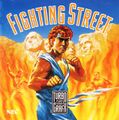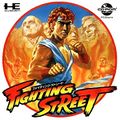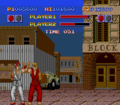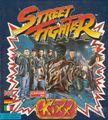(Stubbing in for now) |
(Page complete) |
||
| Line 1: | Line 1: | ||
{{Header Nav|game=Street Fighter}} | {{Header Nav|game=Street Fighter}} | ||
== Fighting Street for the TurboGrafx-16 / PC Engine == | |||
''Street Fighter'' was ported under the title ''Fighting Street'' in 1988 for the PC Engine CD ROM in Japan (the first video game in the world on CD-ROM format) and 1989 for the TurboGrafx-CD in North America. This version features an arranged soundtrack. Due to the lack of a six-button controller available for the TurboGrafx-16 at the time this version was released, the strength level of the attacks were determined by how long either of the action buttons were held. This version was published by [[NEC|NEC Avenue]] in North America and [[Hudson Soft]] in Japan and was developed by [[Alfa System]]. The cover artwork featured Mount Rushmore, which was one of the locations in the game. | |||
<gallery> | |||
File:Fighting Street TGCD box.jpg|American cover | |||
File:Fighting Street PCECD box.jpg|Japanese cover | |||
File:Fighting Street TGCD screen.png|Screenshot | |||
</gallery> | |||
=== Secrets === | |||
;Alternate ending:Normally when you beat the game, you will observe your player (Ryu or Ken) boarding an airplane to leave. If you beat the game four times in a row however, you will be treated to an alternate scene where your player is exiting the plane and arriving at his destination, which a crowd of reporters waiting to take his picture. | |||
;Cheat codes:There are a set of cheats which can only be enabled by entering the correct initials in the high score table. You must first play the game and achieve a high score, enter the correct initials, and then allow the game to end. When the title screen turns black, press {{tg16|Left|Dpad}}{{plus}}{{tg16|I}}{{plus}}{{tg16|II}}{{plus}}{{tg16|Select}}. If successful, the title screen will advance to the game select screen. | |||
{| {{Prettytable}} | |||
! Initials || Effect | |||
|- | |||
| <code>.HU</code> || Start the game with 7 continue credits. | |||
|- | |||
| <code>.AS</code> || Stage selection | |||
|- | |||
| <code>.LK</code> || Start the game with 7 continue credits, plus stage selection. | |||
|- | |||
| <code>.SD</code> || All of the effects of the .LK code, plus the ability to see the ending, and the ability to enter easy special move commands (see below). | |||
|} | |||
The easy moves are as follows (assumes you are facing right. Mirror the direction if you are facing left): | |||
{| {{Prettytable|notwide=1}} | |||
! Easy command || Special attack | |||
|- | |||
| {{tg16|Right|Dpad}}{{plus}}{{tg16|Select}} || Hadouken | |||
|- | |||
| {{tg16|Left|Dpad}}{{plus}}{{tg16|Select}} || Hurricane Kick | |||
|- | |||
| {{tg16|Down|Dpad}}{{plus}}{{tg16|Right|Dpad}}{{plus}}{{tg16|Select}} || Shoryuken | |||
|} | |||
== Home computer conversions == | |||
=== Amstrad CPC === | |||
[[File:Street Fighter CPC screen.png|thumb|left|Screenshot]] | |||
[[File:Street Fighter CPC box.jpg|thumb|right|Box artwork]] | |||
Published by [[U.S. Gold]] in 1988 in Europe. These ports were developed by Tiertex. | |||
{{-}} | |||
=== Atari ST === | |||
[[File:Street Fighter AST screen.png|thumb|left|Screenshot]] | |||
[[File:Street Fighter AST box.jpg|thumb|right|Box artwork]] | |||
Published by [[U.S. Gold]] in 1988 in Europe. These ports were developed by Tiertex. Uses the 16-bit processing capability of the machine for a considerably close conversion of the arcade game. On par with the Commodore Amiga version. | |||
{{-}} | |||
=== Commodore 64 === | |||
The [[Commodore 64]] actually got two versions, published on the same tape/disk - the NTSC (US) version developed by Capcom USA, and the PAL (UK) version by Tiertex. This edition of ''Street Fighter'' was featured in two compilations: ''Arcade Muscle'' and ''Multimixx 3'', both of which featured other U.S. Gold-published ports of Capcom games such as ''[[Bionic Commando]]'' and ''[[1943: The Battle of Midway]]''. | |||
<gallery> | |||
File:Street Fighter C64 box EU.jpg|European box art | |||
File:Street Fighter C64 screen EU.png|European screenshot | |||
File:Street Fighter C64 box US.jpg|American box art | |||
File:Street Fighter C64 screen US.png|American screenshot | |||
</gallery> | |||
=== Commodore Amiga === | |||
Published by [[U.S. Gold]] in 1988 in Europe. These ports were developed by Tiertex. Uses the 16-bit processing capability of the machine for a considerably close conversion of the arcade game. On par with the Atari ST version. | |||
<gallery> | |||
File:Street Fighter AMI box EU.jpg|European box art | |||
File:Street Fighter AMI box US.jpg|American box art | |||
File:Street Fighter AMI screen.png|Screenshot | |||
</gallery> | |||
=== MS-DOS === | |||
[[File:Street Fighter DOS screen.png|thumb|left|Screenshot]] | |||
[[File:Street Fighter DOS box.jpg|thumb|right|Box artwork]] | |||
[[Hi-Tech Expressions]] ported the game to MS-DOS computers. Hi-Tech also re-released the game as part of the ''Street Fighter Series'' CD-ROM collection. Only largely available in the United States, the box art is notable for it's similarity to contemporary [[Capcom]] releases for the [[NES]]. | |||
{{-}} | |||
=== Sinclair ZX Spectrum === | |||
[[File:Street Fighter ZX screen.png|thumb|left|Screenshot]] | |||
[[File:Street Fighter ZX box.jpeg|thumb|right|Box artwork]] | |||
Published by [[U.S. Gold]] in 1988 in Europe. These ports were developed by Tiertex. | |||
{{Footer Nav|game=Street Fighter|prevpage=|nextpage=}} | {{Footer Nav|game=Street Fighter|prevpage=|nextpage=}} | ||
Revision as of 03:32, 14 August 2016
Fighting Street for the TurboGrafx-16 / PC Engine
Street Fighter was ported under the title Fighting Street in 1988 for the PC Engine CD ROM in Japan (the first video game in the world on CD-ROM format) and 1989 for the TurboGrafx-CD in North America. This version features an arranged soundtrack. Due to the lack of a six-button controller available for the TurboGrafx-16 at the time this version was released, the strength level of the attacks were determined by how long either of the action buttons were held. This version was published by NEC Avenue in North America and Hudson Soft in Japan and was developed by Alfa System. The cover artwork featured Mount Rushmore, which was one of the locations in the game.
-
American cover
-
Japanese cover
-
Screenshot
Secrets
- Alternate ending
- Normally when you beat the game, you will observe your player (Ryu or Ken) boarding an airplane to leave. If you beat the game four times in a row however, you will be treated to an alternate scene where your player is exiting the plane and arriving at his destination, which a crowd of reporters waiting to take his picture.
- Cheat codes
- There are a set of cheats which can only be enabled by entering the correct initials in the high score table. You must first play the game and achieve a high score, enter the correct initials, and then allow the game to end. When the title screen turns black, press
+
+
+
. If successful, the title screen will advance to the game select screen.
| Initials | Effect |
|---|---|
.HU |
Start the game with 7 continue credits. |
.AS |
Stage selection |
.LK |
Start the game with 7 continue credits, plus stage selection. |
.SD |
All of the effects of the .LK code, plus the ability to see the ending, and the ability to enter easy special move commands (see below). |
The easy moves are as follows (assumes you are facing right. Mirror the direction if you are facing left):
| Easy command | Special attack |
|---|---|
| Hadouken | |
| Hurricane Kick | |
| Shoryuken |
Home computer conversions
Amstrad CPC


Published by U.S. Gold in 1988 in Europe. These ports were developed by Tiertex.
Atari ST


Published by U.S. Gold in 1988 in Europe. These ports were developed by Tiertex. Uses the 16-bit processing capability of the machine for a considerably close conversion of the arcade game. On par with the Commodore Amiga version.
Commodore 64
The Commodore 64 actually got two versions, published on the same tape/disk - the NTSC (US) version developed by Capcom USA, and the PAL (UK) version by Tiertex. This edition of Street Fighter was featured in two compilations: Arcade Muscle and Multimixx 3, both of which featured other U.S. Gold-published ports of Capcom games such as Bionic Commando and 1943: The Battle of Midway.
-
European box art
-
European screenshot
-
American box art
-
American screenshot
Commodore Amiga
Published by U.S. Gold in 1988 in Europe. These ports were developed by Tiertex. Uses the 16-bit processing capability of the machine for a considerably close conversion of the arcade game. On par with the Atari ST version.
-
European box art
-
American box art
-
Screenshot
MS-DOS


Hi-Tech Expressions ported the game to MS-DOS computers. Hi-Tech also re-released the game as part of the Street Fighter Series CD-ROM collection. Only largely available in the United States, the box art is notable for it's similarity to contemporary Capcom releases for the NES.
Sinclair ZX Spectrum
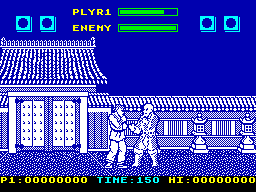
Published by U.S. Gold in 1988 in Europe. These ports were developed by Tiertex.

